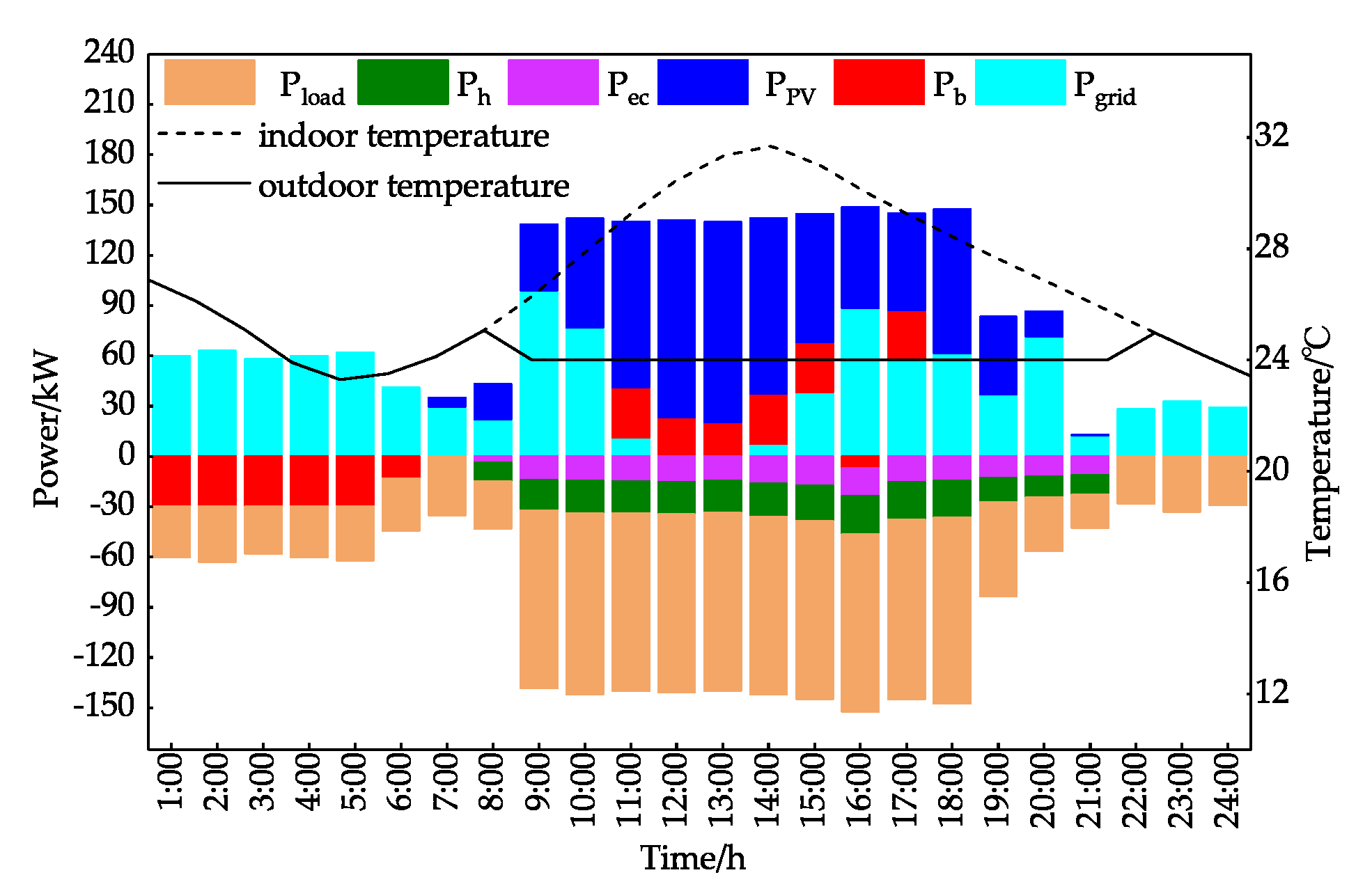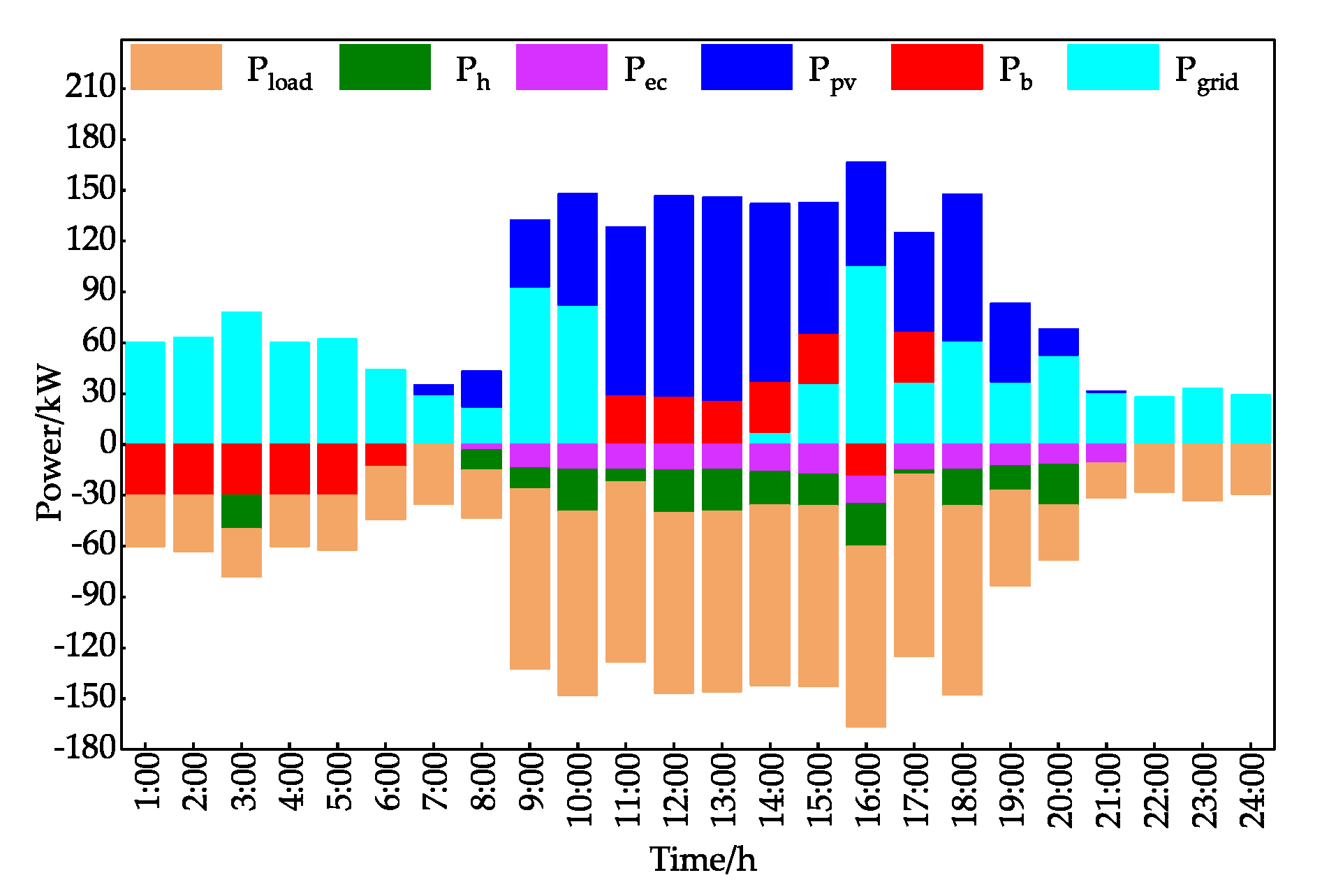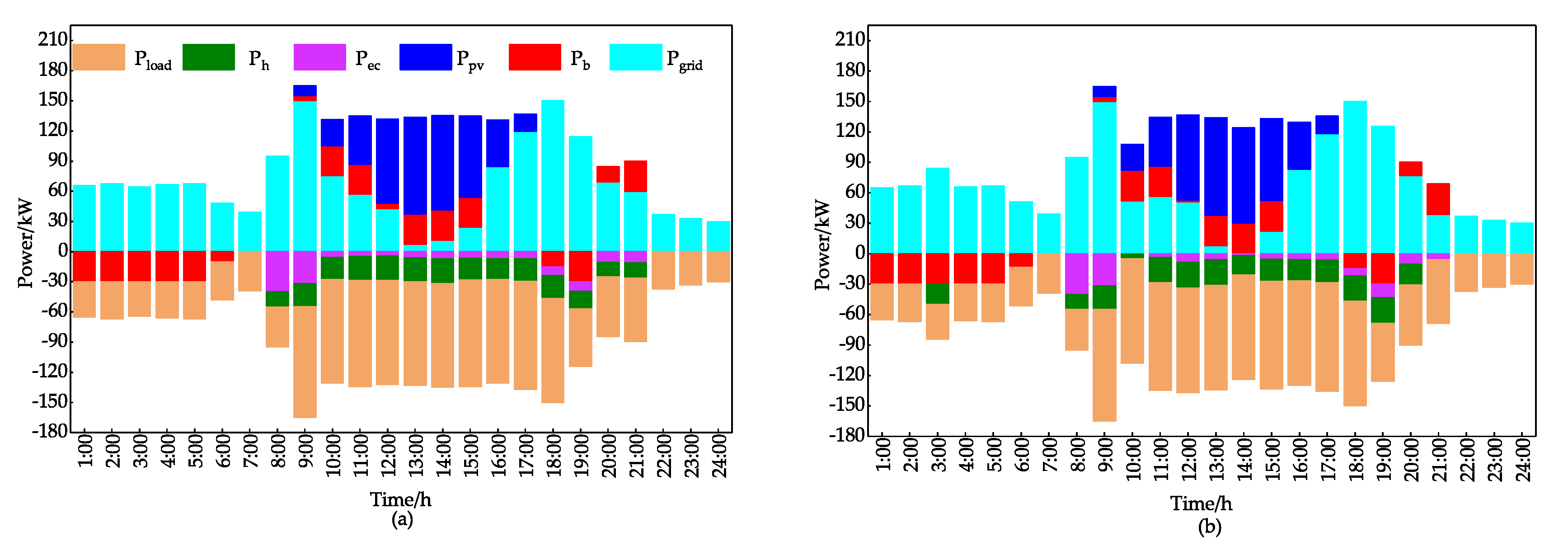This paper first takes the summer cooling scenario as an example for simulation. In the scenario, four cases are established: case 1: VES is not considered; case 2: Only EWHVES is considered; case 3: only ACVES is considered; case 4: both EWHVES and ACVES are considered. Then, in order to verify the effectiveness of the strategy proposed in this paper, simulations are performed in different seasons.
6.2.2. The Summer Cooling Scenario Simulation Analysis
Case 1: VES is not considered
VES is not adopted in the system, which means that the AC injects cool air into the building to maintain the indoor temperature at 24 Celsius, and the water heater adopts a ready-to-use model, not equipped with a tank.
Figure 5 depicts the optimal scheduling results in the summer.
In
Figure 5, the power ≥0 represents the output power of PV, battery and the main grid. The power <0 represents the power consumed by loads, the charging power of the battery and the power sold to the main grid.
Figure 5 shows that during non-working hours, due to the low electricity price, the system purchases electricity from the main grid to meet the electrical load demand in the building and charges the battery. During working hours, PV generator provides power for the system, the cost of purchasing electricity is reduced. Most of the working time, the battery is in the discharge state, but at 16:00, because the price of electricity is relatively lower than the adjacent time, the battery is charged. The cost of running the system in a day when VES is not considered is
$165.06.
Case 2: Only EWHVES is considered
As shown in
Figure 6, which plots the optimal scheduling result of BIPV microgrid when only EWHVES is considered in summer.
As can be seen from
Figure 6, at 3:00, due to the low electricity price, the EWH works and inject hot water into the tank for use during the working hours. At 11:00, due to the high electricity price, the power exchanged between the system and the main grid changes to 0, which reduces the system’s electricity cost.
Figure 7 shows the EWHVES and battery charging/discharging power and their state of charge.
As shown in
Figure 7, power ≤0 represents charging, and power >0 represents discharging. During non-working hours, the electricity price is low, both the battery and the WHVES are charged, meanwhile, both reach the maximum state of charge. During the working period, the battery discharges. Due to its limited capacity, the EWHVES is in a discharged state at a high electricity price time, and in a charged state at low electricity price time. As mentioned above, both of them charge when the electricity price is low, and discharge when the electricity price is high, which play the role of peak load shaving. The BIPV microgrid costs
$152.46 operating a day when only the EWHVES is adopted, which reduces 7.63% than that in case of without VES.
In order to prove that the EWHVES can replace the battery to a certain extent, reduce part of the capacity of the battery to simulation, the result shows that when reducing 78 kWh capacity of the battery, the system has the same cost as the scene where the VES is not considered.
Case 3: Only ACVES is considered
The AC is turned on only during working hours. The indoor temperature is adjusted from the original fixed 24 Celsius to the upper and lower limit of 22–26 Celsius. The penalty factor of user comfort is 0.1. The optimal scheduling results of BIPV microgrid adopts ACVES is shown in
Figure 8.
As the figure above shows, at 11:00 and 17:00 with higher electricity price, the AC only consumes little electric energy to keep the room temperature in the comfort zone, which plays the role of peak load shaving and reduces the operating cost of the system. The BIPV microgrid costs
$152.46 a day when only ACVES is considered, which is 5.67% less than the operating cost of the microgrid without VES. The charging/discharging of ACVES and indoor/outdoor temperature variation are shown in
Figure 9.
AS can be seen in
Figure 9, at 10:00 and 16:00 with higher electricity price, the ACVES is charged and the indoor temperature drops to 22 Celsius, next moment, the ACVES is discharged and the indoor temperature rises to 26 Celsius. The ACVES is charged when the electricity price is low, and discharged when the electricity price is high, playing a similar role to the battery. In order to illustrate that ACVES can supersede battery, reduce the certain capacity of battery to simulation, the result shows that when reducing 61 kWh capacity of the battery, the system has the same cost as the scene that the VES is not considered.
Compared with the EWH, the AC only need to adjust the indoor temperature to achieve VES, additional equipment is not required. However, ACVES is affected by weather, indoor temperature zone, building parameters and other factors, which cannot be quantified its capacity specifically. Moreover, the ACVES can only play its role in winter and summer, cannot provide stable VES utility. The WHVES is less affected by the external environment, and the energy storage utility is stable, but in the early stage of system construction, the tank equipment needs to be invested.
Case 4: Both EWHVES and ACVES are considered
In order to maximize the effectiveness of VES, the two types of VES are integrated into the BIPV microgrid for optimal scheduling. The results are shown in
Figure 10.
The system costs
$144.69 to operating for a day, which is 12.34% less than the operating cost of the microgrid without VES. We reduced the capacity of the battery and set the system to have the same daily operating cost as the system without VES. The simulation results show that VES has the effect of 115 kWh of battery capacity. The operating cost of the system under four scenarios is shown in
Table 4.
Table 4 summarizes the cost of the system under four scenarios. It is clear that VES can reduce the operating cost of the system. When two kinds of VES are integrated into the system, the cost saved is not the linear superposition of the effect when they participate in the system separately.


















